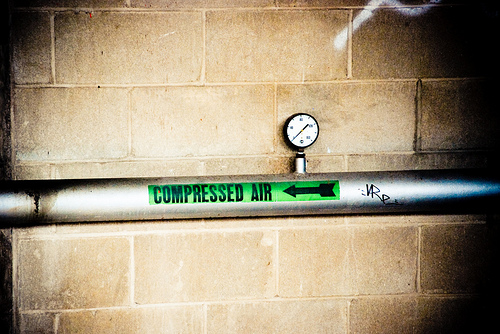Compressed Air
Jump to navigation
Jump to search
Compressed air is one of the basic utilities, next to water, electricity and gas. In some situations, it can replace these other utilities, providing flexibility (see product ecology, below). It could be generated by small wind installations which are mechanically coupled to air compressor. Alternatively, solar photovoltaic cells could power an electric air compressor, although this arrangement is likely more expensive.

Walton Colliery - steam powered air compressor. This magnificent machine was at one end of this colliery's power house. It was an inverted vertical compound steam engine with the steam cylinders direct coupled to two stage compressor cylinders below. It was built by Belliss & Morcom of Birmingham in 1922. The steam cylinders were 23" & 33" x 17" and it developed 715 indicated horsepower at 250 rpm. The steam pressure is thought to have been 150 psi. It was disused by 1977 and scrapped in 1982 following the closure of the colliery.
Applications and product ecology
- for energy storage (CAES, compressed air energy storage), see energy storage Wikipedia
- compressed air could be "co-fired" with biogas for electricity generation, saving gas
- pneumatic motors for all sorts of uses, replacing electric or hydraulic motors
- run power tools, examples here and also here
- pneumatic transportation (see Treehugger article on FoodTubes)
- Compressed Air Water Pump
- various ventilation uses (e.g. air exchange in greenhouses, Passivhaus, underground mine, etc.), as an alternative to electric fans
- drying of fuel biomass (... wood, manure, etc.) before further uses, such as combustion, pyrolysis
- drying and processing of (bio-)materials using vortex dehydration ("Windhexe")
- using vortex tube for separation of atmospheric gases: yields nitrogen (for food preservation) and oxygen (to co-fire with gas and reach higher temperatures for metallurgical applications)
- aeration of water in aquaculture and to make compost tea
- aeration of compost: so-called "Aerated Static Pile" (ASP) composting: https://en.wikipedia.org/wiki/Aerated_static_pile_composting
- control air flow in updraft and other gasifiers such as a TLUD
- inflatable structures (greenhouses, tents, other temporary installations)
- cooling (possibly via vortex tube); for making Freeze Dried Fruit Powders
- generate compressed air via (solar) heat engine that directly powers an air compressor
- various applications that benefit from having very hot flames (compressed air provides increased oxygen for hotter combustion)
- hypothetical device that precisely controls the temperature of a flame by regulating the flow of compressed air into flame and using a feedback mechanism that is controlled by an Arduino (useful to generate precisely carbonized materials for example)
